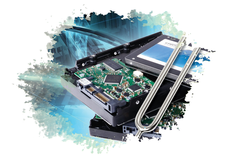Optimize flash memory in Linux
Fine-tuned

Solid state drives make everything run faster and more smoothly, but you can squeeze out even more performance with some practical optimization steps.
Solid-State drives (SSDs) are quite different from old-fashioned hard disks, and you'll have to learn some new techniques if you want to tune up performance. This article highlights some important steps for optimizing SSDs.
Updating the Firmware
Firmware is just as important as hardware, and the flash chips in the SSD are no exception. Special software mechanisms such as wear leveling and garbage collection improve the efficiency of the drive; without these mechanisms, the durability and performance of the SSD would be impaired over its service life. The firmware is thus an important part of the product, and it is also under constant development, which means it is important to update the firmware.
Linux users are often a little envious when they see how easy it is to install new firmware in Windows by clicking around in a graphical interface. Intel and Samsung provide Linux binaries for their datacenter SSDs, but for their consumer products, users need to boot an ISO file.
[...]
Buy this article as PDF
(incl. VAT)
